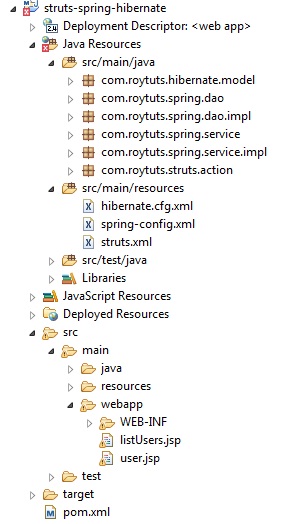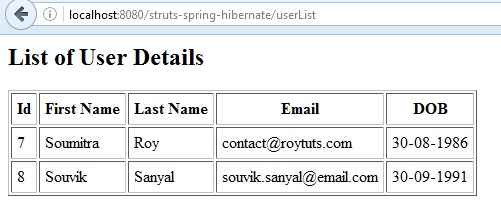In this tutorial I will show you how to integrate Struts 2, Spring 4, Hibernate 4 and Maven. In the previous example Integrate Spring 3, Struts 2 and Hibernate 3 , I have shown how to integrate Struts 2, Spring 3 and Hibernate 3 but I have not used maven there.
For this tutorial we will create maven based web project in Eclipse.
If you already have an idea on how to create a maven project in Eclipse will be great otherwise I will tell you here how to create a maven project in Eclipse.
Prerequisites
The following configurations are required in order to run the application
Eclipse Kepler
JDK 1.8
Tomcat 8
Have maven installed and configured
Struts 2, Spring 4, Hibernate 4 dependencies in pom.xml
Now we will see the below steps how to create a maven based project in Eclipse
Step 1. Create a maven based web project in Eclipse
Go to File -> New -> Other. On popup window under Maven select Maven Project. Then click on Next. Select the workspace location – either default or browse the location. Click on Next. Now in next window select the row as highlighted from the below list of archtypes and click on Next button.
maven-arctype-webapp
Now enter the required fields (Group Id, Artifact Id) as shown below
Group Id : com.roytuts
Artifact Id : struts-spring-hibernate
The created project looks like below
Step 2. Modify the pom.xml file as shown below.
<project xmlns="http://maven.apache.org/POM/4.0.0" xmlns:xsi="http://www.w3.org/2001/XMLSchema-instance"
xsi:schemaLocation="http://maven.apache.org/POM/4.0.0 http://maven.apache.org/maven-v4_0_0.xsd">
<modelVersion>4.0.0</modelVersion>
<groupId>com.roytuts</groupId>
<artifactId>struts-spring-hibernate</artifactId>
<packaging>war</packaging>
<version>0.0.1-SNAPSHOT</version>
<name>struts-spring-hibernate Maven Webapp</name>
<url>http://maven.apache.org</url>
<properties>
<java.version>1.8</java.version>
<spring.version>4.1.4.RELEASE</spring.version>
<struts2.version>2.3.16.2</struts2.version>
<hibernate.version>4.3.8.Final</hibernate.version>
<mysqlconnector.version>5.1.34</mysqlconnector.version>
</properties>
<dependencies>
<!-- Spring 4 -->
<dependency>
<groupId>org.springframework</groupId>
<artifactId>spring-context</artifactId>
<version>${spring.version}</version>
</dependency>
<dependency>
<groupId>org.springframework</groupId>
<artifactId>spring-orm</artifactId>
<version>${spring.version}</version>
</dependency>
<!-- struts 2 -->
<dependency>
<groupId>org.apache.struts</groupId>
<artifactId>struts2-core</artifactId>
<version>${struts2.version}</version>
</dependency>
<!-- struts 2 & spring -->
<dependency>
<groupId>org.apache.struts</groupId>
<artifactId>struts2-spring-plugin</artifactId>
<version>${struts2.version}</version>
</dependency>
<!-- hibernate 4 -->
<dependency>
<groupId>org.hibernate</groupId>
<artifactId>hibernate-core</artifactId>
<version>${hibernate.version}</version>
</dependency>
<!-- database pool -->
<dependency>
<groupId>org.apache.commons</groupId>
<artifactId>commons-dbcp2</artifactId>
<version>2.0</version>
</dependency>
<!-- mysql java connector -->
<dependency>
<groupId>mysql</groupId>
<artifactId>mysql-connector-java</artifactId>
<version>${mysqlconnector.version}</version>
</dependency>
</dependencies>
<build>
<finalName>struts-spring-hibernate</finalName>
<plugins>
<!-- use jdk 1.8 -->
<plugin>
<groupId>org.apache.maven.plugins</groupId>
<artifactId>maven-compiler-plugin</artifactId>
<configuration>
<source>${java.version}</source>
<target>${java.version}</target>
</configuration>
</plugin>
</plugins>
</build>
</project>Step 3. If you see JRE System Library[J2SE-1.5] then change the version by below process
Do right-click on the project and go to Build -> Configure build path, under Libraries tab click on JRE System Library[J2SE-1.5], click on Edit button and select the appropriate jdk 1.8 from the next window. Click on Finish then Ok.
Change also the Compiler compliance level as 1.8 from Java -> Compiler.
Step 4. Now when the build process finished then modify the web.xml file with below source code
<?xml version="1.0" encoding="UTF-8"?>
<web-app version="3.0" xmlns="http://java.sun.com/xml/ns/javaee"
xmlns:xsi="http://www.w3.org/2001/XMLSchema-instance"
xsi:schemalocation="http://java.sun.com/xml/ns/javaee http://java.sun.com/xml/ns/javaee/web-app_3_0.xsd">
<!-- load spring configuration -->
<context-param>
<param-name>contextConfigLocation</param-name>
<param-value>classpath:spring-config.xml</param-value>
</context-param>
<!-- load spring context -->
<listener>
<listener-class>org.springframework.web.context.ContextLoaderListener
</listener-class>
</listener>
<!-- struts 2 filter and URL mapping -->
<filter>
<filter-name>struts2</filter-name>
<filter-class>org.apache.struts2.dispatcher.ng.filter.StrutsPrepareAndExecuteFilter
</filter-class>
</filter>
<filter-mapping>
<filter-name>struts2</filter-name>
<url-pattern>/*</url-pattern>
</filter-mapping>
</web-app>Step 5. Create spring-config.xml file under src/main/resources directory with the below source code
<?xml version="1.0" encoding="UTF-8"?>
<beans xmlns="http://www.springframework.org/schema/beans"
xmlns:xsi="http://www.w3.org/2001/XMLSchema-instance" xmlns:p="http://www.springframework.org/schema/p"
xmlns:aop="http://www.springframework.org/schema/aop" xmlns:context="http://www.springframework.org/schema/context"
xmlns:jee="http://www.springframework.org/schema/jee" xmlns:tx="http://www.springframework.org/schema/tx"
xmlns:task="http://www.springframework.org/schema/task"
xsi:schemaLocation="http://www.springframework.org/schema/aop http://www.springframework.org/schema/aop/spring-aop-4.1.xsd http://www.springframework.org/schema/beans http://www.springframework.org/schema/beans/spring-beans-4.1.xsd http://www.springframework.org/schema/context http://www.springframework.org/schema/context/spring-context-4.1.xsd http://www.springframework.org/schema/jee http://www.springframework.org/schema/jee/spring-jee-4.1.xsd http://www.springframework.org/schema/tx http://www.springframework.org/schema/tx/spring-tx-4.1.xsd http://www.springframework.org/schema/task http://www.springframework.org/schema/task/spring-task-4.1.xsd">
<!-- support spring annotation -->
<context:annotation-config />
<!-- support annotation transaction -->
<tx:annotation-driven />
<!-- declare datasource -->
<bean id="dataSource"
class="org.springframework.jdbc.datasource.DriverManagerDataSource">
<property name="driverClassName" value="com.mysql.jdbc.Driver" />
<property name="url" value="jdbc:mysql://localhost:3306/cdcol" />
<property name="username" value="root" />
<property name="password" value="" />
</bean>
<!--Hibernate session factory configuration -->
<bean id="sessionFactory"
class="org.springframework.orm.hibernate4.LocalSessionFactoryBean">
<property name="dataSource" ref="dataSource" />
<!-- load hibernate configuration file -->
<property name="configLocation" value="classpath:hibernate.cfg.xml" />
<!-- where to find the ORM classes -->
<property name="packagesToScan" value="com.roytuts.hibernate.model" />
</bean>
<!-- Transaction manager -->
<bean id="transactionManager"
class="org.springframework.orm.hibernate4.HibernateTransactionManager">
<property name="sessionFactory" ref="sessionFactory"></property>
</bean>
<!-- Spring and Struts beans -->
<!-- action -->
<bean id="userDetailsAction" class="com.roytuts.struts.action.UserDetailsAction" />
<!-- service -->
<bean id="userDetailsService" class="com.roytuts.spring.service.impl.UserDetailsServiceImpl" />
<!-- dao -->
<bean id="userDetailsDao" class="com.roytuts.spring.dao.impl.UserDetailsDaoImpl" />
</beans>Step 6. Create hibernate.cfg.xml file under src/main/resources directory
<?xml version="1.0" encoding="UTF-8"?>
<!DOCTYPE hibernate-configuration PUBLIC "-//Hibernate/Hibernate Configuration DTD 3.0//EN" "http://hibernate.sourceforge.net/hibernate-configuration-3.0.dtd">
<hibernate-configuration>
<session-factory>
<!-- MySQL database -->
<property name="hibernate.dialect">org.hibernate.dialect.MySQLDialect</property>
<!-- show SQL in console -->
<property name="hibernate.show_sql">true</property>
<!-- readable format for SQL output in the console -->
<property name="format_sql">true</property>
</session-factory>
</hibernate-configuration>Step 7. Create struts.xml file under src/main/resources directory
<?xml version="1.0" encoding="UTF-8"?>
<!DOCTYPE struts PUBLIC
"-//Apache Software Foundation//DTD Struts Configuration 2.0//EN"
"http://struts.apache.org/dtds/struts-2.0.dtd">
<struts>
<package name="default" namespace="/" extends="struts-default">
<!-- get single user details -->
<!-- below class userDetailsAction is mapped in spring-config.xml file -->
<action name="user" class="userDetailsAction" method="getAUserDetails">
<result name="success">/user.jsp</result>
</action>
<!-- get all users details -->
<action name="userList" class="userDetailsAction" method="getAllUserDetails">
<result name="success">/listUsers.jsp</result>
</action>
</package>
</struts>Step 8. Create MySQL table user_details in database cdcol
USE `cdcol`; /*Table structure for table `user_details` */ DROP TABLE IF EXISTS `user_details`; CREATE TABLE `user_details` ( `id` int(10) unsigned NOT NULL AUTO_INCREMENT, `first_name` varchar(20) COLLATE utf8_unicode_ci NOT NULL, `last_name` varchar(15) COLLATE utf8_unicode_ci NOT NULL, `email` varchar(100) COLLATE utf8_unicode_ci NOT NULL, `dob` varchar(16) COLLATE utf8_unicode_ci NOT NULL, PRIMARY KEY (`id`) ) ENGINE=InnoDB AUTO_INCREMENT=9 DEFAULT CHARSET=utf8 COLLATE=utf8_unicode_ci;
Step 9. Dump some data into the table
/*Data for the table `user_details` */ insert into `user_details`(`id`,`first_name`,`last_name`,`email`,`dob`) values (7,'Soumitra','Roy','contact@roytuts.com','30-08-1986'),(8,'Souvik','Sanyal','souvik.sanyal@email.com','30-09-1991');
Step 10. Now create Entity bean class which will map Java object to database table user_details
package com.roytuts.hibernate.model;
import javax.persistence.Column;
import javax.persistence.Entity;
import javax.persistence.GeneratedValue;
import javax.persistence.GenerationType;
import javax.persistence.Id;
import javax.persistence.Table;
@Entity
@Table(name = "user_details")
public class UserDetails {
@Id
@GeneratedValue(strategy = GenerationType.AUTO)
@Column(name = "id")
private int id;
@Column(name = "first_name")
private String firstName;
@Column(name = "last_name")
private String lastName;
@Column(name = "email")
private String email;
@Column(name = "dob")
private String dob;
public UserDetails() {
}
public UserDetails(int id, String firstName, String lastName, String email, String dob) {
this.id = id;
this.firstName = firstName;
this.lastName = lastName;
this.email = email;
this.dob = dob;
}
public int getId() {
return id;
}
public void setId(int id) {
this.id = id;
}
public String getFirstName() {
return firstName;
}
public void setFirstName(String firstName) {
this.firstName = firstName;
}
public String getLastName() {
return lastName;
}
public void setLastName(String lastName) {
this.lastName = lastName;
}
public String getEmail() {
return email;
}
public void setEmail(String email) {
this.email = email;
}
public String getDob() {
return dob;
}
public void setDob(String dob) {
this.dob = dob;
}
}Step 11. Create DAO interface for querying database table
package com.roytuts.spring.dao;
import java.util.List;
import com.roytuts.hibernate.model.UserDetails;
public interface UserDetailsDao {
public UserDetails getuserDetails(int id);
public List<UserDetails> getAllUserDetails();
}
Step 12. Create the corresponding DAO implementation class
package com.roytuts.spring.dao.impl;
import java.util.List;
import org.hibernate.SessionFactory;
import org.springframework.beans.factory.annotation.Autowired;
import org.springframework.transaction.annotation.Transactional;
import com.roytuts.hibernate.model.UserDetails;
import com.roytuts.spring.dao.UserDetailsDao;
public class UserDetailsDaoImpl implements UserDetailsDao {
@Autowired
private SessionFactory sessionFactory;
@Transactional
@Override
public UserDetails getuserDetails(int id) {
UserDetails userDetails = (UserDetails) sessionFactory.getCurrentSession().get(UserDetails.class, id);
return userDetails;
}
@Transactional
@Override
public List<UserDetails> getAllUserDetails() {
@SuppressWarnings("unchecked")
List<UserDetails> userDetails = (List<UserDetails>) sessionFactory.getCurrentSession()
.createCriteria(UserDetails.class).list();
//or below query
/*
* @SuppressWarnings("unchecked") List<UserDetails> userDetails =
* (List<UserDetails>)sessionFactory.getCurrentSession().createQuery(
* "from UserDetails").list();
*/
return userDetails;
}
public SessionFactory getSessionFactory() {
return sessionFactory;
}
}Step 13. Create the service interface for processing logic or business logic
package com.roytuts.spring.service;
import java.util.List;
import com.roytuts.hibernate.model.UserDetails;
public interface UserDetailsService {
public UserDetails getuserDetails(int id);
public List<UserDetails> getAllUserDetails();
}Step 14. Create the corresponding service implementation class
package com.roytuts.spring.service.impl;
import java.util.List;
import org.springframework.beans.factory.annotation.Autowired;
import com.roytuts.hibernate.model.UserDetails;
import com.roytuts.spring.dao.UserDetailsDao;
import com.roytuts.spring.service.UserDetailsService;
public class UserDetailsServiceImpl implements UserDetailsService {
@Autowired
private UserDetailsDao userDetailsDao;
@Override
public UserDetails getuserDetails(int id) {
return userDetailsDao.getuserDetails(id);
}
@Override
public List<UserDetails> getAllUserDetails() {
return userDetailsDao.getAllUserDetails();
}
public UserDetailsDao getUserDetailsDao() {
return userDetailsDao;
}
}Step 15. Create struts 2 action class which will handle user request and response
package com.roytuts.struts.action;
import java.util.List;
import org.apache.struts2.dispatcher.DefaultActionSupport;
import org.springframework.beans.factory.annotation.Autowired;
import com.roytuts.hibernate.model.UserDetails;
import com.roytuts.spring.service.UserDetailsService;
public class UserDetailsAction extends DefaultActionSupport {
private static final long serialVersionUID = 1L;
@Autowired
private UserDetailsService userDetailsService;
private UserDetails userDetails;
private List<UserDetails> userDetailsList;
public String getAUserDetails() {
if (userDetails == null) {
int id = 7;// should come from UI
userDetails = userDetailsService.getuserDetails(id);
}
return SUCCESS;
}
public String getAllUserDetails() {
if (userDetailsList == null) {
userDetailsList = userDetailsService.getAllUserDetails();
}
return SUCCESS;
}
public UserDetails getUserDetails() {
return userDetails;
}
public void setUserDetails(UserDetails userDetails) {
this.userDetails = userDetails;
}
public List<UserDetails> getUserDetailsList() {
return userDetailsList;
}
public void setUserDetailsList(List<UserDetails> userDetailsList) {
this.userDetailsList = userDetailsList;
}
public UserDetailsService getUserDetailsService() {
return userDetailsService;
}
}Step 16. Now create user.jsp file for displaying single user details
<%@ page language="java" contentType="text/html; charset=ISO-8859-1"
pageEncoding="ISO-8859-1"%>
<%@ taglib prefix="s" uri="/struts-tags"%>
<html>
<head>
<title>Struts 2, Spring 4 and Hibernate 4 Integration Example</title>
<s:if test="userDetails != null">
<h2>User Details</h2>
<table cellpadding="5px" border="1px">
<tbody>
<tr>
<th>Id</th>
<th>First Name</th>
<th>Last Name</th>
<th>Email</th>
<th>DOB</th>
</tr>
<tr>
<td><s:property value="userDetails.id"></s:property></td>
<td><s:property value="userDetails.firstName"></s:property></td>
<td><s:property value="userDetails.lastName"></s:property></td>
<td><s:property value="userDetails.email"></s:property></td>
<td><s:property value="userDetails.dob"></s:property></td>
</tr>
</tbody>
</table>
</s:if>
</body>
</html>In the above file we have used struts 2 taglib for accessing the bean property.
Step 17. Create listusers.jsp file for displaying all users details
<%@ page language="java" contentType="text/html; charset=ISO-8859-1"
pageEncoding="ISO-8859-1"%>
<%@ taglib prefix="s" uri="/struts-tags"%>
<html>
<head>
<title>Struts 2, Spring 4 and Hibernate 4 Integration Example</title>
<s:if test="userDetailsList.size() > 0">
<h2>List of User Details</h2>
<table cellpadding="5px" border="1px">
<tbody>
<tr>
<th>Id</th>
<th>First Name</th>
<th>Last Name</th>
<th>Email</th>
<th>DOB</th>
</tr>
<s:iterator value="userDetailsList">
<tr>
<td><s:property value="id"></s:property></td>
<td><s:property value="firstName"></s:property></td>
<td><s:property value="lastName"></s:property></td>
<td><s:property value="email"></s:property></td>
<td><s:property value="dob"></s:property></td>
</tr>
</s:iterator>
</tbody>
</table>
</s:if>
</body>
</html>Step 18. Now run the application on Tomcat server 8 and when the application successfully deployed onto the server, please hit the URL http://localhost:8080/struts-spring-hibernate/userList , you will below output in the browser
The corresponding console output
Hibernate: select userdetail0_.id as id1_0_0_, userdetail0_.dob as dob2_0_0_, userdetail0_.email as email3_0_0_, userdetail0_.first_name as first_na4_0_0_, userdetail0_.last_name as last_nam5_0_0_ from user_details userdetail0_ where userdetail0_.id=?
When you hit the URL http://localhost:8080/struts-spring-hibernate/user in the browser, you will see the below output
The corresponding console output
Hibernate: select this_.id as id1_0_0_, this_.dob as dob2_0_0_, this_.email as email3_0_0_, this_.first_name as first_na4_0_0_, this_.last_name as last_nam5_0_0_ from user_details this_
Thanks for reading.


